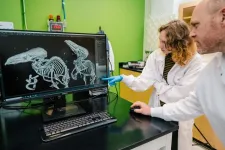(Press-News.org) If you’re among the 1.5 billion people worldwide using TikTok, you may have come across exceptional “testimonials” like Nikola Tesla or Marie Curie delivering short science-related messages that have garnered millions of views. This is just one of many examples where AI-generated avatars are used to communicate science — a strategy that might also have its drawbacks.
The generation of images and animations through artificial intelligence is a rapidly growing field, constantly improving in quality. Yet many avatars, though realistic, still present minor flaws — glitches, delays, inconsistent facial expressions or lip-syncing — sometimes barely noticeable, but still easily picked up by a human observer.
Jasmin Baake, researcher at the Center for Advanced Internet Studies (CAIS), Bochum, Germany, and the other authors of the study realized that these avatars could trigger a phenomenon known in cognitive science as the “uncanny valley.” The uncanny valley describes a human reaction to humanoid avatars (digital or robotic): when they look hyper-realistic but not quite perfect, they may evoke strong discomfort, while more stylized or cartoonish humanoid figures tend not to. The uncanny valley can provoke outright rejection in viewers, and Baake and colleagues wondered to what extent the humanlike characteristics of AI-avatars representing science communicators influence the trustworthiness attributed to them by the viewer. “We wanted to do research on the perception of these avatars and especially on how their degree of realism and their gender might impact the trustworthiness perception of the recipient,” explains Baake.
The study (conducted in Germany, in German) involved a series of videos featuring AI-generated avatars portraying science communicators — both male and female. The experimental conditions were four, varying by avatar realism (very high vs. cartoonish style) and gender (male or female). The nearly 500 participants were recruited through a representative online sample in Germany, selected to reflect the population in terms of age, gender, and education.
“For the degree of realism, we assumed that with the uncanny valley hypothesis in mind, the more stylistic avatars, so the ones that looked a bit more cartoonish, would be perceived as more trustworthy”, says Baake, “and, based on existing literature on gendered perceptions of science communicators — which show that male scientists are often associated with greater competence — combined with concerns that AI-generated avatars may reflect and reinforce such stereotypes due to biased training data, we hypothesized that male avatars would be perceived as more competent, and therefore more trustworthy overall, than female avatars.”
However, Baake and colleagues were surprised: in their experiments, the realistic avatars were rated more positively than the cartoon-style ones. In particular, the questionnaires given to participants after viewing the videos assessed perceived competence, integrity, and benevolence of the avatars, which together reflect perceived trustworthiness. The more realistic avatars scored slightly higher across all three dimensions. As for gender, the effect was partial: male avatars were perceived as more competent, but no significant differences were found in terms of integrity or benevolence.
“With our findings, we could not find a descent into the uncanny valley with a higher degree of realism, at least in our conditions,” comments Baake. Additionally, individual factors — such as viewers’ prior AI knowledge and trust in science — were found to moderate trustworthiness perceptions. According to the study’s findings, more realistic, human-like avatars appear to be suitable for communicating scientific content. However, Baake emphasizes that while no uncanny valley effect was found here, future studies should test a broader range of realism levels to investigate whether an intermediate uncanny valley effect might emerge between the two conditions tested so far, and whether people perceive the realism of avatars differently depending on the observer.
END
No “uncanny valley” effect in science-telling AI avatars
For science communication, realistic avatars may foster more trustworthiness than cartoon-like ones, says a new paper in JCOM
2025-04-15
ELSE PRESS RELEASES FROM THIS DATE:
New UNCG research shows southern shrews shrink in winter
2025-04-15
Newly published research from UNC Greensboro biology professor Dr. Bryan McLean and colleagues shows that the masked shrew, a small, mole-like mammal found in the Appalachian Mountains, shrinks its body and braincase to conserve energy during winter months. The study, published in the May 2025 issue of The American Naturalist, found that the masked shrew (Sorex cinereus) reduces its body mass by 13 percent in the colder months; the creature then grows larger in spring when conditions improve. In addition to a shrinking body, the team also found seasonal changes in the height of the creature’s ...
Children exposed to brain-harming chemicals while sleeping
2025-04-15
Babies and young children may breathe and absorb plasticizers called phthalates, flame retardants, and other harmful chemicals from their mattresses while they sleep, according to a pair of peer-reviewed studies published today from the University of Toronto in Environmental Science & Technology and Environmental Science & Technology Letters. These chemicals are linked to neurological and reproductive problems, asthma, hormone disruption, and cancer.
"Sleep is vital for brain development, ...
Emotions and levels of threat affect communities’ resilience during extreme events
2025-04-15
Hoboken, N.J., April 14, 2025 — Tightly connected communities tend to be more resilient when facing extreme events such as earthquakes, hurricanes, floods or wildfires, says Jose Ramirez-Marquez, who develops metrics to analyze, quantify and ultimately improve performance of urban systems.
Ramirez-Marquez, associate professor and division director of Enterprise Science and Engineering at Stevens, who grew up in the earthquake-prone Mexico City knows this first-hand. “Whenever there's an earthquake, a city-wide alarm goes off and everybody leaves wherever they are and stays in the middle of the street — that’s a prevention phase,” he says. ...
New CONSORT reporting guidelines published today in five medical journals
2025-04-14
Under embargo until 23:30 (UK), Monday April 14, 2025
An updated set of guidelines to improve transparency and clarity in the reporting of randomised controlled trials have been published today. The CONSORT (Consolidated Standards of Reporting Trials) 2025 statement provides a minimum set of essential items that should be included when reporting the results of randomised trials.
First published in 1996, the CONSORT guidelines saw additional updates in 2001 and 2010. Becoming the gold standard for reporting randomised trials, ...
Experts stress importance of vaccination amidst measles outbreaks
2025-04-14
Pediatric infectious diseases experts stress the importance of vaccination against measles, one of the most contagious viruses, which is once more spreading in the United States. In the article published in Pediatrics, they update pediatricians on this vaccine-preventable disease, which was previously declared non-endemic in the U.S.
“The most effective way to prevent measles is vaccination,” said lead author Caitlin Naureckas Li, MD MHQS, infectious diseases specialist at Ann & Robert H. Lurie Children’s Hospital of Chicago and Assistant Professor of Pediatrics at Northwestern University ...
Enabling stroke victims to 'speak': $19 million toward brain implants to be built at U-M
2025-04-14
Images
A new collaboration between the University of Michigan and Stanford University aims to give stroke patients the ability to "speak" by detecting and interpreting brain signals, using the world's smallest computers linked up to the world's most biocompatible sensors.
The Marcus Foundation announced today a $29.7 million grant, led by Stanford, that would benefit victims of aphasic stroke, who are often left struggling to communicate. U-M will receive $19 million of the total grant.
According to the American Heart Association, stroke is the leading cause of disability in the ...
Study captures sharp uptake in use of new weight loss and glucose-lowering medications
2025-04-14
When it comes to managing weight loss and type 2 diabetes with medications, research shows that it’s out with the old and in with the new. Investigators from Mass General Brigham looked at claims data from nearly 2 million people between 2021 and 2023 and their findings highlight a shifting landscape for weight loss and glucose managing medications. Those changes include a sharp climb in the use of newly approved medications, especially tirzepatide, which is sold under the brand name Mounjaro for diabetes treatment and Zepbound for weight loss. The use of medications previously common in the treatment of type 2 diabetes, including metformin, sulfonylureas, and insulin, decreased. Results ...
Van Andel Institute to recognize Dr. J. Timothy Greenamyre with 2025 Jay Van Andel Award for Outstanding Achievement in Parkinson’s Disease Research
2025-04-14
GRAND RAPIDS, Mich. (April 14, 2025) — Van Andel Institute has named renowned physician-scientist J. Timothy Greenamyre, M.D., Ph.D., as recipient of its 2025 Jay Van Andel Award for Outstanding Achievement in Parkinson’s Disease Research.
The award will be presented during Grand Challenges in Parkinson’s Disease, VAI’s flagship annual Parkinson’s disease symposium, Sept. 9–10, 2025.
Greenamyre’s pioneering research into the interactions between genes and the environment has vastly improved our understanding of Parkinson’s development and progression. He has published more than 200 articles detailing ...
One firearm injury was treated every 30 minutes in emergency departments in a study of 10 jurisdictions
2025-04-14
Embargoed for release until 5:00 p.m. ET on Monday 14 April 2025
Follow @Annalsofim on X, Facebook, Instagram, Threads, and LinkedIn
Below please find summaries of new articles that will be published in the next issue of Annals of Internal Medicine. The summaries are not intended to substitute for the full articles as a source of information. This information is under strict embargo and by taking it into possession, media representatives are committing to the terms of the embargo not only on their own behalf, but also on behalf of the organization they represent.
----------------------------
1. ...
The gut health benefits of sauerkraut
2025-04-14
Is sauerkraut more than just a tangy topping? A new University of California, Davis, study published in Applied and Environmental Microbiology suggests that the fermented cabbage could help protect your gut, which is an essential part of overall health, supporting digestion and protecting against illness.
Authors Maria Marco, professor with the Department of Food Science and Technology, and Lei Wei, a postdoctoral researcher in Marco’s lab, looked at what happens during fermentation — specifically, how the metabolites ...
LAST 30 PRESS RELEASES:
Pusan National University researchers discover faster, smarter heat treatment for lightweight magnesium metals
China’s 2024 Gastroenterology Report: marked progress in endoscopy quality and disease management
Pusan National University researchers uncover scalable method for ultrahigh-resolution quantum dot displays
Researchers use robotics to find potential new antibiotic among hundreds of metal complexes
Gut bacteria changes at the earliest stages of inflammatory bowel disease
Scientists develop new way to “listen in” on the brain’s hidden language
Brain research: “Pulse generators” grow and shrink as memories are formed
For teens, any cannabis use may have impact on emotional health, academic performance
School meals could unlock major gains for human and planetary health
Menopause hormone therapy does not appear to impact dementia risk
Signature patterns of brain activity may help predict recovery from traumatic brain injury
Dresden study uncovers new key mechanism in cancer cells
New species are now being discovered faster than ever before, study suggests
Cannabis-based products show limited short-term benefit for chronic pain, with increased risk of adverse effects
Cannabis products with more THC slightly reduce pain but cause more side effects
Clearing the brain of aging cells could aid epilepsy and reduce seizures
Brain injuries linked with potential risk of suicide, new study finds
New technique lights up where drugs go in the body, cell by cell
New study finds movement of fishing fleets can reveal shifts in marine ecosystems
Embargoed: New evidence points to potential treatment for vascular dementia
Study uncovers disrupted brain balance in alcohol dependence
Working in groups can help Republicans and Democrats agree on controversial content moderation online
Structural findings reveal how distinct GPCR ligands create different levels of activation
Anything-goes “anyons” may be at the root of surprising quantum experiments
UC review: Maximizing workplace opportunity for veterans
From generation to complex control: Metasurfaces make perfect vortex beams "within reach"
Thin-film lithium niobate-based detector: recent advances and perspectives
Exploring why some people may tend to persistently make bad choices
How cells balance their protein levels
Nirsevimab vs RSVpreF vaccine for RSV–related hospitalization in newborns
[Press-News.org] No “uncanny valley” effect in science-telling AI avatarsFor science communication, realistic avatars may foster more trustworthiness than cartoon-like ones, says a new paper in JCOM


